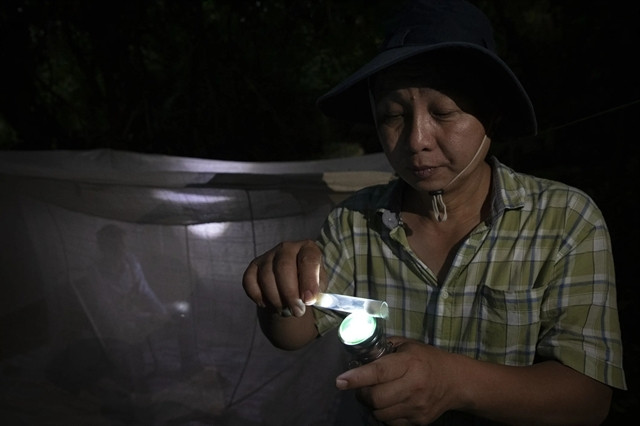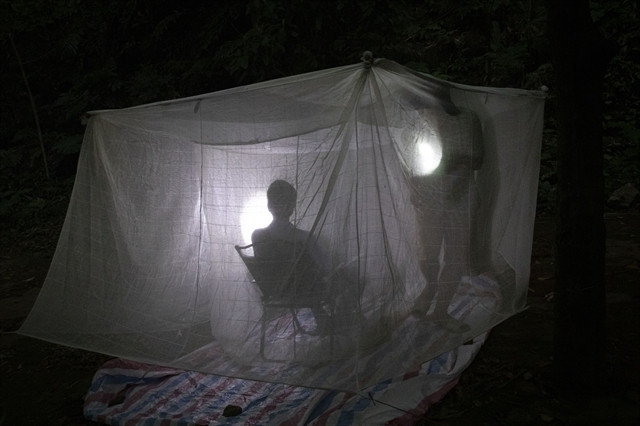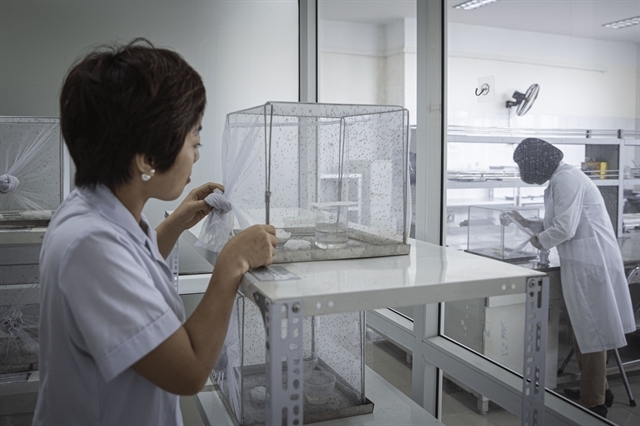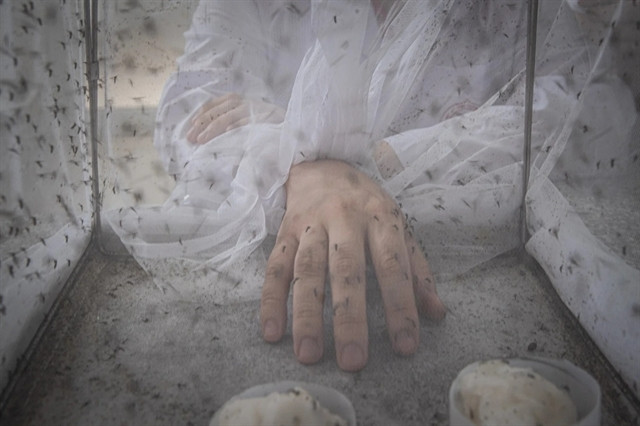 |
| Lê Thanh Thảo, an officer from the National Institute of Malariology, Parasitology and Entomology captures disease-carrying mosquitoes from a pre-prepared net in the core area of Ba Vì National Park in Hà Nội. — Photos nhandan.vn |
As dusk falls, Vũ Việt Hưng, an officer from the National Institute of Malariology, Parasitology and Entomology, along with his colleagues, began their routine mosquito-hunting trip in the core area of Ba Vì National Park in Hà Nội.
Dressed neatly in protective gear, Hưng stretched out a pre-prepared net, leaving its base about 40cm off the ground and turned on a soft light. Inside, his colleague, Lê Thành Trung, sat on a folding chair to serve as bait.
Within minutes, mosquitoes from all directions started buzzing in. They slipped under the net, hovered near the ears and boldly landed on the hands of the bait. Swarms of mosquitoes, resembling football-sized clouds, with their buzzing wings, quickly flied above the mosquito hunters before descending onto exposed skin to bite.
Vũ Việt Hưng, an officer from the Anopheles Unit of the Department of Entomology, told Nhân Dân (People) online newspaper that hunting mosquitoes in the wild is a planned activity by the National Institute of Malariology, Parasitology and Entomology. It supports biological experiments, surveillance and investigation of viruses transmitting dengue fever and malaria in humans, thereby warning people to proactively implement disease prevention measures.
"Mosquito hunting takes place in various locations, in forests, among households or in livestock pens. In recent years, the method of using direct bait by exposing arms and legs for mosquitoes to land and then capturing them with a tube is no longer used in some international projects due to ethical concerns. However, if conducted properly with suitable protective measures, it remains one of the most effective methods for hunting disease-carrying mosquitoes," Hưng said.
Despite the itching, burning and raised welts on their hands and feet, no one dared to scratch.
"All captured mosquitoes must be alive and intact. So, no matter how itchy it gets, we have to endure it," Trung whispered.
More mosquitoes gathered, spotting the white net with black dots. Lê Thanh Thảo quietly approached, shone a light on a female mosquito with an upturned abdomen and black-and-white scales on its wings and gently captured it in a test tube.
Thảo explained that when the net trap is set up, various types of mosquitoes will enter. At this point, the bait must remain still to allow colleagues to filter and select the right species to capture.
Mosquitoes in the wild
He said that adult Anopheles mosquitoes are dark brown and black. Their body length typically matches the length of their proboscis. These mosquitoes are most active from around 7-9pm daily, so after sunset. Sometimes, in order to catch just one or two specific individuals, team members must endure dozens of bites.
Hưng further explained that mosquito hunting is influenced by various factors such as time, weather and climate. As a result, there are nights when the team catches hundreds of mosquitoes, but there are also times when they only harvest a few individuals.
 |
| An officer sits on a folding chair to serve as bait to lure mosquitoes. |
Additionally, depending on the species, mosquitoes will concentrate in specific areas. For example, Anopheles dirus primarily appears in the forested areas of the Central Highlands, while the malaria vector in the northern region is Anopheles minimus. Dengue fever mosquitoes, on the other hand, are more common in cities, he said.
After catching more than a dozen Anopheles mosquitoes, Thảo decided to replace Trung as the mosquito bait. The 50-year-old man quickly changed into shorts, exposing his lower thighs and calves, then took a chair to a dark corner and sat quietly.
In no time, Thảo's legs turned black with mosquitoes. Under the beam of his headlamp, he carefully observed and used a glass tube to capture a mosquito that was engorged with blood.
Hưng mentioned that to achieve maximum effectiveness, mosquito hunters should avoid using fragrant soap, perfume or essential oils before starting their work. Moreover, those who directly serve as bait must be thoroughly trained in identification methods.
"After many years, we can identify the species of a mosquito with 80 per cent accuracy just by its flight," he said.
Additionally, those directly involved must know how to protect themselves to avoid getting sick. If they are working in areas with high mosquito density, they must take preventive medication.
The method of using human bait to catch mosquitoes at night is regulated according to the Ministry of Health's guidelines on malaria surveillance and prevention, issued on October 25, 2021, in Decision No. 4922/QĐ-BYT.
The staff recalled that everyone in the team had a history of contracting malaria and dengue fever several times, except for Thảo.
Thảo reminisced about 1997 when he and his colleagues went to Vĩnh Hà and Vĩnh Linh districts in the central province of Quảng Trị to survey a malaria outbreak. At that time, two of them brought only a limited amount of medication for emergencies.
At the commune health station, they met a young Vân Kiều ethnic patient who had contracted malaria and was about to enter a severe phase. The clinic had run out of medicine and if the patient had to be transferred to the district hospital, the chances of survival would be very slim.
"In that situation, our team didn't hesitate to give our preventive medicine to the child. When he passed the critical phase, we all breathed a sigh of relief."
Mosquitoes in the lab
After being captured, mosquitoes are classified before being brought into the lab at the National Institute of Malariology, Parasitology and Entomology.
 |
| Mosquitoes are placed in breeding rooms for research purposes. |
Pointing to a tray full of wriggling larvae, Đào Minh Trang, deputy head of the Department of Entomology, said that once mosquitoes are captured in the field, they are placed in breeding rooms for research purposes. This research aims to find effective prevention measures and suitable chemicals for extermination. The mosquito breeding process includes feeding cycles, facilitating mating and laying eggs, and taking care of the larvae.
To keep mosquitoes alive, the breeding rooms are specially arranged with air conditioning running almost around the clock and maintaining absolute cleanliness. The temperature is strictly controlled and kept at 26 degrees Celsius. Additionally, humidity levels must adhere to the most stringent regulations.
"Some mosquito species are very difficult to mate in captivity, so we have to employ artificial methods. Moreover, each year we supply thousands of mosquitoes to various departments and research institutions both within and outside the Institute for scientific research, so we frequently need to facilitate their mating," she said.
Nguyễn Trường An, a young officer in the Mosquito Breeding Unit, explained that he has to be at the unit by 7am daily to check technical parametres, feed the larvae, pick out those about to become mosquitoes to place them in cages and clean the trays.
"For female mosquitoes, we allow them to directly suck blood to increase the hatching rate of eggs later," he said.
An explained that depending on the mosquito strain, the feeding time lasts from 15 to 20 minutes. This process can be observed visually, put simply, when mosquitoes stop biting, it means they are full.
 |
| A volunteer directly feeds female mosquitoes to increase the hatching rate of eggs. |
"Initially, I was scared, but now I'm used to it. Moreover, our research helps the community, so everyone tries their best," he said.
Nguyễn Văn Dũng, head of the Department of Entomology, said that despite the challenges faced during mosquito hunting and breeding, the staff's dedication and responsibility toward their work have made significant contributions to research. This research helps identify mosquito characteristics, leading to the development of optimal disease prevention measures. — VNS